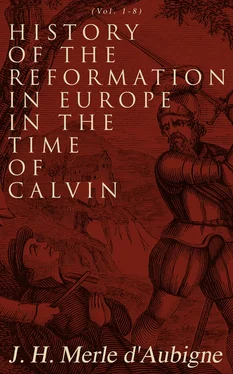J. H. Merle D'Aubigné - History of the Reformation in Europe in the Time of Calvin (Vol. 1-8)
Здесь есть возможность читать онлайн «J. H. Merle D'Aubigné - History of the Reformation in Europe in the Time of Calvin (Vol. 1-8)» — ознакомительный отрывок электронной книги совершенно бесплатно, а после прочтения отрывка купить полную версию. В некоторых случаях можно слушать аудио, скачать через торрент в формате fb2 и присутствует краткое содержание. Жанр: unrecognised, на английском языке. Описание произведения, (предисловие) а так же отзывы посетителей доступны на портале библиотеки ЛибКат.
- Название:History of the Reformation in Europe in the Time of Calvin (Vol. 1-8)
- Автор:
- Жанр:
- Год:неизвестен
- ISBN:нет данных
- Рейтинг книги:4 / 5. Голосов: 1
-
Избранное:Добавить в избранное
- Отзывы:
-
Ваша оценка:
- 80
- 1
- 2
- 3
- 4
- 5
History of the Reformation in Europe in the Time of Calvin (Vol. 1-8): краткое содержание, описание и аннотация
Предлагаем к чтению аннотацию, описание, краткое содержание или предисловие (зависит от того, что написал сам автор книги «History of the Reformation in Europe in the Time of Calvin (Vol. 1-8)»). Если вы не нашли необходимую информацию о книге — напишите в комментариях, мы постараемся отыскать её.
History of the Reformation in Europe in the Time of Calvin (Vol. 1-8) — читать онлайн ознакомительный отрывок
Ниже представлен текст книги, разбитый по страницам. Система сохранения места последней прочитанной страницы, позволяет с удобством читать онлайн бесплатно книгу «History of the Reformation in Europe in the Time of Calvin (Vol. 1-8)», без необходимости каждый раз заново искать на чём Вы остановились. Поставьте закладку, и сможете в любой момент перейти на страницу, на которой закончили чтение.
Интервал:
Закладка:
Berthelier’s death was to have still more serious consequences. His enemies had hoped to stifle liberty by killing him. Perhaps ... but it was one of those deaths which are followed by a glorious resurrection. In the battle which had just been fought noble blood had been spilt, but it was blood that leads to victory at last. Except a corn of wheat fall into the ground and die, it abideth alone; but if it die, it bringeth forth much fruit. Religious liberty had many victims three centuries ago in all the countries of the Reformation; but the noblest martyrs of political liberty, in modern times, have fallen at Geneva (if my judgment does not mislead me), and their death has not been useless to the universal cause of civilisation. Cruciate, torquete, damnate ... sanguis christianorum, semen. The blood of the martyrs is a seed—a seed which takes root and bears fruit, not only in the spot where it has been sown, but in many other parts of the world.
Berthelier’s friends were struck by his contempt of death and assurance of eternal life. They still seemed to hear the noble testimony he had borne to immortality. Hence one of them wrote this noble epitaph for him:—
Quid mihi mors nocuit? Virtus post fata virescit;
Nec cruce nec gladio sævi perit illa tyranni. 274
As we see, the idea of a resurrection, of a life after death, over which man has no power, seems to have been uppermost in the mind of Berthelier as well as of his friends. This man was not a common martyr of liberty.
‘Verily,’ said some, ‘the maxim lately set forth is a true one: Heroes and the founders of republics and empires have, next to God, the greatest right to the adoration of men.’ 275
The bishop hastened to take advantage of his victory. ‘Berthelier’s death,’ said his friend Bonivard, ‘gives the tyrant great comfort, for the watch-dog being killed, he can easily manage the scattered sheep.’ The bishop began, therefore, to move onwards, and undertook to revolutionise Geneva. At first he resolved to change the magistrature. Four days after the execution he assembled the general council, and, assuming the airs of a conqueror, appeared at it with a numerous train. ‘We John of Savoy,’ said he in the document which has been preserved, ‘bishop and prince of Geneva, being informed of the dissensions of this city, have not feared to come hither at great expense to administer by force of arms the most effectual remedy; and we have behaved like a good shepherd. My lord the Duke of Savoy, who singularly loves this city, having desired to enter it, the syndics and the seditious have with incredible annoyance rebelled against a prince so gentle; 276and if this illustrious prince had not been touched with compassion, if he had not surpassed by his clemency the charity of the Redeemer 277... we should all have been destroyed.’ After these strange words from a bishop, who placed the duke above Jesus Christ, at the very time when this prince had made himself the accomplice in a murder, Master Chappuis, the official, called out: ‘Say is it not so?’ None but mamelukes were present at the assembly, and among them several persons who had no right to be there. Many voices shouted, ‘Yes, yes!’ for it was then the reign of terror. The syndics, ‘more ready to yield the bishop their maces than their heads,’ says Bonivard, laid down before him the insignia of their office. The next day another general council elected four mameluke syndics: P. Versonay, P. Montyon, P. de Fernex, and G. Danel, ‘who everywhere and in everything did what the bishop and the duke desired.’ The same day, all huguenots were excluded from the two councils; and the bishop forbade the citizens to carry arms or to assemble by night, under penalty of a fine of twenty-five livres and ten stripes of the cord.
Sorrow and dismay filled men’s hearts. Geneva lay as it were under one of those funeral palls which are stretched over the dead. No one stirred out, no one spoke; all was motionless and silent; the air of despotism could be felt, as it hung over and benumbed the soul. Besançon Hugues, A. Lévrier, and the other patriots retired to their homes; but they had not lost hope; they waited in silence until God should make the cause of liberty to triumph again in their country. 278Erelong, however, a few courageous spirits awoke and began to stir. The patriots felt the need of pouring out their sorrows together; and it was told the bishop ‘that several persons of the huguenot sect 279were in the habit of meeting secretly in various places.’ Then the persecutions began afresh: ‘They spared the good as little as the bad,’ says Bonivard, ‘and accused them of false crimes to be revenged on them.’
A short time before the period we are describing, Amadeus de Joye, one of Berthelier’s friends, had committed an act of little importance in itself, but which was the first sign of opposition in Geneva to the Romish superstitions. Two years earlier Luther had written to Spenlein his beautiful letter on justification by faith; he had expounded the epistle to the Galatians, and probably posted up his theses. Zwingle, who had been appointed preacher at Einsiedeln, was declaiming against pilgrimages, offerings, images, and the invocation of the Virgin and the saints. Had the report of these sermons reached Geneva? It is possible, for, as we have seen, there was constant intercourse between this city and the German cantons. However that may be, many Genevans were already asking if the glory of God ‘was not defiled by so foolish and lifeless a thing as an image?’ Amadeus de Joye, whom we have met before at the Molard assembly, and whom his enemies accused of being the friend of Berthelier, Pécolat, ‘and many other villains,’ felt little respect for the bishop’s dolls . Now there was at Geneva a famous black image of wood, between two and three feet high, called St. Babolin. Certain catholics held it in great devotion, carrying it in long processions, and rendering it every sort of honour. One night when the worshippers of St. Babolin had assembled in the house of Ami Motey, one of their number, De Joye, indignant at their idolatry and thinking the ugly figure was more like a devil than a god, carried it off, and, with the intention of giving a lesson to the partisans of the idol, took it to Motey’s house. The window was open; he listened to the conversation of this devout little circle, and taking courage raised the image as high as the casement and flung it into the midst of its worshippers. It must be acknowledged that this was not controversy of the right sort; but it was the sixteenth century, and the Genevans were of a bold and scoffing humour. The startled followers of Babolin looked with astonishment at their saint, which appeared to have fallen from heaven. All of a sudden the door was opened and a loud voice called out: ‘It is the devil ... he will eat you all!’ At these words, Motey jumped up, caught hold of a javelin and prepared to hurl it at the intruder; but De Joye hastily retired. There were no blows given, and no blood was shed. 280
This incident had been almost forgotten, when the bishop’s agents, who were resolved to be severe upon the friends of liberty, shut up De Joye in the Château de l’Ile, where Berthelier had been imprisoned, and asked the syndics’ permission to question and to torture him in order to get at the truth (7th September, 1519). Besides this affair of the image, he was charged with ‘having been present at illegal meetings where the citizens bound themselves by oath to resist any infringement of their liberties by word or by deed.’ 281The syndics ordered that De Joye should be examined in prison, pede ligato , with the feet bound. The proceedings commenced.
‘I was born of worthy, upright, and distinguished parents,’ said De Joye when he appeared before the syndics, ‘and by them trained up virtuously until the age of manhood. Since then I have associated with all the good men of the city, and in the profession which I follow I have always borne a good reputation. Far from picking quarrels, I have carefully avoided them, and have reconciled many. Finally, I have been all my life faithful and obedient to my lord the bishop.’ 282These words, which we transcribe from the documents in the trial, were of a nature to inspire the judges with a certain respect; but they did not. First Claude du Bois, the vidame’s lieutenant, and next the governor of the castle, proposed that De Joye should be put to the torture to force him to confess the crimes imputed to him; 283but it was decided to begin by examining the witnesses, who told what they had heard say by persons whose names they could not remember . Fine evidence on which to put a man to the torture! 284The governor did not abandon his project; the vidame came in person to urge the syndics to do him this pleasure . 285Could they be denied, when it concerned only a contemner of St. Babolin? Amadeus knew not the Gospel; his opposition to the black image proceeded merely from the disgust which superstition inspires in intelligent minds, and there was in his character more fire than firmness, more impetuosity than perseverance. The mild, weak, and infirm man, who was scared by the idea of torture, fancied his limbs already dislocated, and beginning to weep he offered to make oath of his innocence on the relics of St. Anthony. To all the questions put to him he replied only by groans and tears. The vidame, whose heart was hardened, again demanded that he should be put to the torture. ‘My right arm is crippled,’ exclaimed the poor wretch; ‘the sinews are contracted.’ Two surgeons declared, after examination, that he might be able to bear the strappado, but could not support the torture of the chatte without fainting. 286There were in the executioner’s list punishments for all temperaments, for the sick and crippled as well as for the strong. De Joye, who, after he had sown his wild oats, had become a respectable citizen, was neither a hero nor a revolutionist. The embarrassed judges, not finding sufficient cause in the Babolin joke to put a man to death, helped him to escape during the night, and so saved appearances. The persecutions of the bishop were not limited to a single individual. John of Savoy took delight in power, and wished to show the cardinals that he was strong enough to put down revolt. ‘They imprisoned,’ says Bonivard, ‘they beat, they tortured, they beheaded and hanged, so that it was quite pitiful.’ 287Geneva was crushed.
Читать дальшеИнтервал:
Закладка:
Похожие книги на «History of the Reformation in Europe in the Time of Calvin (Vol. 1-8)»
Представляем Вашему вниманию похожие книги на «History of the Reformation in Europe in the Time of Calvin (Vol. 1-8)» списком для выбора. Мы отобрали схожую по названию и смыслу литературу в надежде предоставить читателям больше вариантов отыскать новые, интересные, ещё непрочитанные произведения.
Обсуждение, отзывы о книге «History of the Reformation in Europe in the Time of Calvin (Vol. 1-8)» и просто собственные мнения читателей. Оставьте ваши комментарии, напишите, что Вы думаете о произведении, его смысле или главных героях. Укажите что конкретно понравилось, а что нет, и почему Вы так считаете.







![Hubert Bancroft - The Native Races [of the Pacific states], Volume 5, Primitive History](/books/749157/hubert-bancroft-the-native-races-of-the-pacific-s-thumb.webp)




